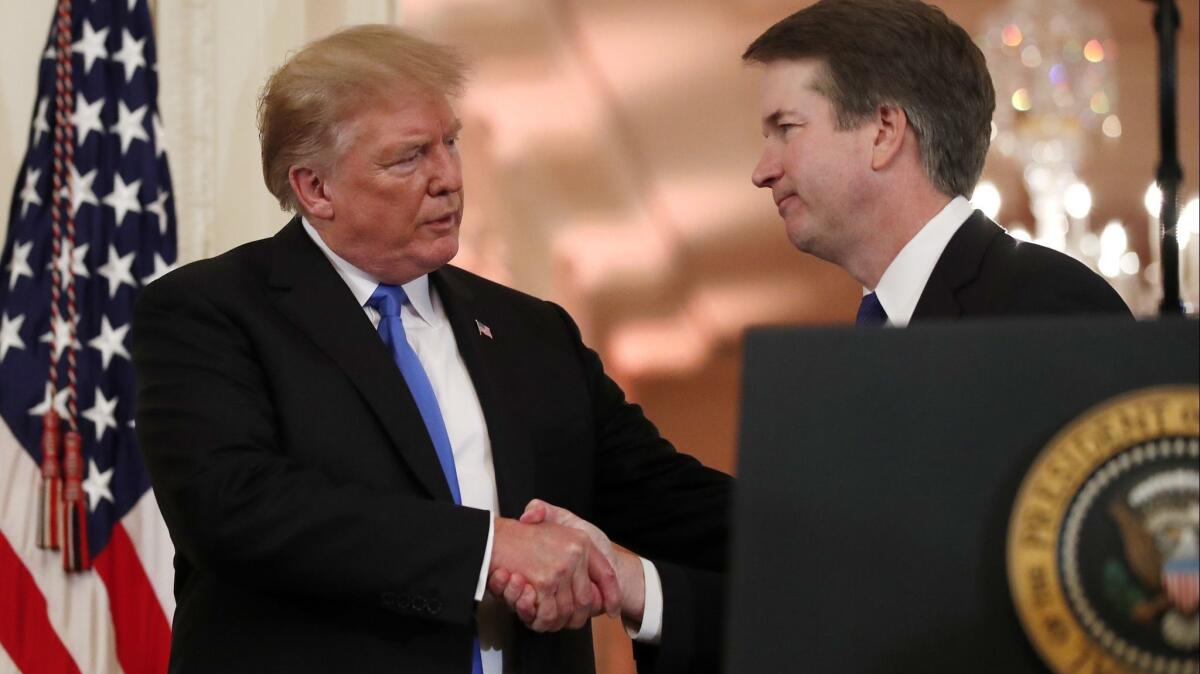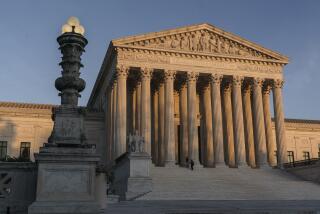Editorial: Can the Supreme Court confirmation process ever be repaired?

- Share via
With his nomination of Brett Kavanaugh to the Supreme Court, President Trump has chosen an experienced federal judge with a conservative record whose profile is less ideological than those of some other candidates he considered. Given the number of fire-breathing right-wing judges that Trump had to choose from, he could have done a whole lot worse.
Kavanaugh should be questioned closely by senators about his views of the Constitution, the role of precedent and, yes, what he thinks of Roe vs. Wade, the 1973 decision legalizing abortion. Yet no matter what Kavanaugh says at his confirmation hearings, he is likely to be opposed by most if not all Democrats, just as Justice Neil M. Gorsuch was last year when Trump nominated him to the seat that should have gone to Merrick Garland, former President Obama’s nominee to succeed the late Antonin Scalia. Senate Republicans refused even to give Garland a hearing, keeping the Scalia seat open for more than a year in the hopes that it would be filled, as it was, by a Republican president.
If anything, Democratic senators may resist Kavanaugh’s nomination even more strenuously than they did Gorsuch’s. After all, Gorsuch replaced another consistent conservative. Kavanaugh is being nominated to succeed Justice Anthony M. Kennedy, who, while he often joined with the court’s conservatives, sided with liberal justices in reaffirming a woman’s right to abortion and extending marriage to same-sex couples. If Kavanaugh is confirmed, he could cement a conservative majority on an array of other questions from campaign finance law to civil liberties.
The judicial system works best when judicial nominees are neither rigidly ideological nor biased along partisan lines.
These are the unhappy results of an increasingly bitter, increasingly partisan, increasingly dysfunctional judicial selection process.
To be clear, we have plenty of concerns about the appointment of a “reliably conservative” new justice. We share the Democrats’ unease about this nomination and what it means for the court. We worry about the future of reproductive freedom, about the prospects for criminal justice reform and about the fulfillment of the 14th Amendment’s promise of equal protection, to name just a few issues that hang in the balance. This page supported the Democrats who voted against Gorsuch to protest the outrageous obstruction of Garland.
Yet in the same editorial last year we reaffirmed our long-standing view that presidents generally should receive deference from the Senate so long as their nominees to the court are well-qualified and in the broad mainstream of legal thought. That was why we endorsed, for example, President George W. Bush’s nomination of John G. Roberts Jr. to be chief justice even though he was likely to rule in ways we disagreed with much of the time.
The judicial system works best when judicial nominees are neither rigidly ideological nor biased along partisan lines — and when the Senate doesn’t inject those factors into the process. Placing the emphasis on legal acumen, qualifications and judicial temperament helps promote a Supreme Court that can remain above politics even if individual justices bring different philosophies to the bench. Of course presidents will choose nominees with views similar to their own, but changes in the White House over time can help ensure that the court doesn’t become overly identified with one party or ideology, or not for too long. The goal is to have more justices who act and are seen as disinterested interpreters of the Constitution rather than as “politicians in robes.”
The agonizing question is whether it’s possible to restore an arrangement in which nominations to the court are not occasions for scorched-earth partisan conflicts. We’d still like to think so, but even before the outrage of the Garland blockade, there were alarming signs in the Senate and on the court itself that the ideal of justice removed from politics was under siege.
Enter the Fray: First takes on the news of the minute from L.A. Times Opinion »
For more than two decades, presidents of both parties have seen well-qualified, philosophically mainstream judicial nominees blocked or filibustered by senators of the opposite party. Nominations to the Supreme Court also have become more partisan.
In a speech in 2016, Roberts noted that while Scalia and Justice Ruth Bader Ginsburg were confirmed by near-unanimous votes, “you look at more recent colleagues, all extremely well-qualified for the court, and the votes were strictly on party lines for the last three. That does not make any sense.”
As the Senate has divided on party lines in considering judicial nominations, the Supreme Court in politically sensitive cases has split between Democratic and Republic appointees, as it did in last month’s decisions upholding Trump’s travel ban and holding that public employees have a 1st Amendment right not to pay fees to unions that represent them in collective bargaining. In the past, philosophical differences on the court didn’t neatly track party distinctions. For example, in Roe vs. Wade, both the majority and the minority were composed of justices appointed by presidents of both parties.
Whatever the outcome of Kavanaugh’s nomination — and we’ll reserve judgment until after the hearings — respect for the Supreme Court will suffer if confirmation of its members and the votes that they cast are seen as nothing more than exercises in partisan politics.
Follow the Opinion section on Twitter @latimesopinion and Facebook
More to Read
A cure for the common opinion
Get thought-provoking perspectives with our weekly newsletter.
You may occasionally receive promotional content from the Los Angeles Times.









